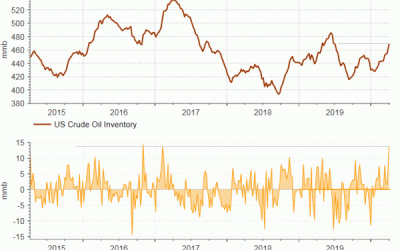Happy New Year everyone! This is our first article for the year 2022. May the new year bring you peace, joy, and happiness!
Monday
Monday 3rd of January is a public holiday.
Tuesday
On Tuesday, we have the OPEC meeting. OPEC and its allies meet on Tuesday for their monthly output setting decision. The alliance will probably stick to its existing plan of adding 400,000 bpd each month. Although Omicron has cast a shadow over the demand outlook heading into 2022, the disruptions to air travel from surging virus cases is expected to be temporary and many countries are still facing an energy crunch.
The loonie could gain if OPEC+ sound upbeat about the demand picture but also important will be Friday’s employment figures for Canada. The Canadian economy added an impressive 153.7k jobs in November but December could have been a more difficult month for the labour market as Omicron swept the country.
In other Canadian releases, the Ivey PMI is also due on Friday.
Risky currencies on Omicron alert
It’s going to be extremely quiet for the other commodity-linked currencies as there’s no major data out of Australia and New Zealand. But with investors somewhat undecided about how much of an impact Omicron will have on the global economy, any headlines about fresh restrictions could hurt the riskier currencies, including the pound.
Wednesday
On Wednesday, we have the FOMC Meeting minutes. It’s going to be a gradual return to business as usual in most countries except in the United States where it’s set to be a full-on week. The ISM manufacturing PMI is the first top-tier data to greet 2022 on Tuesday. The closely watched manufacturing activity gauge is expected to point to an easing in the PMI from 61.1 to 60.2 in December. If the decline is led by a fall in the priced paid component, that may not be such a bad thing. On the other hand, weaker new orders and a still elevated prices paid index could worry investors.
The JOLTS job openings for November on Tuesday and the ADP private payrolls print due Wednesday will keep traders guessing about the labour market ahead of the all-important jobs report on Friday. Factory orders and the ISM non-manufacturing PMI out on Thursday will be the other key data to be watched prior to Friday.
But of course, all eyes will be on the NFP figures, especially after November’s surprise miss and the swelling of Covid-19 cases in recent weeks. Analysts are forecasting an increase of 400k jobs in December and for the unemployment rate to tick lower to 4.1%. Average hourly earnings are expected to have eased from 4.8% to 4.1% year-on-year.
Friday
The most important news for the week, is the Nonfarm Payrolls. Friday January 7th’s release will be reporting jobs data for December 2021. Did the market end last year on a strong footing?
When November’s jobs data was released in December, it was a disappointment. 210,000 new roles were added to the US economy during that month, coming in way below the 573,000 Dow Jones estimate.
Even so, the unemployment rate sharply fell to 4.2% against 4.5% estimated. The labour participation force was also at its highest rate since March 2020, coming in at 61.8%.
Interestingly, the hospitality sector saw job creation fall away in the review month. This industry has been one of, if not the, leading jobs creator across the year, but only 23,000 new hospitality and leisure positions were created in November 2021.
That particular industry has managed to regain nearly seven million positions across the course of the pandemic. However, a 1.3 million deficit remains against February’s 2020’s numbers. The sector’s unemployment rate appears stuck at 7.5%.
While the initial outlook for November painted a bleaker picture of stalling jobs growth, it may not be entirely accurate. We’ve seen revisions across each month so far – normally upward – and could see the same again come January.
For example, the September and October 2021 estimates were revised upwards by a combined 82,000 positions in December. We could still see the same with January’s jobs report.
Despite weaker-than-expected numbers, the Fed doesn’t seem put off by the tighter job section when it comes to 2022’s tapering plans.
We offer trading in crypto CFDs including Bitcoin, Ethereum, Ripple, Litecoin and we many more are on the way! Sign up and start trading now! https://live.crm.puremarketbroker.com/vu/signup
Disclaimer: All writers’ opinions are their own and do not constitute financial advice in any way whatsoever. Nothing published by Pure Market Broker constitutes an investment recommendation, nor should any data or Content published by Pure Market Broker be relied upon for any investment activities.
Pure Market Broker strongly recommends that you perform your own independent research and/or speak with a qualified investment professional before making any financial decisions
Happy New Year everyone! This is our first article for the year 2022. May the new year bring you peace, joy, and happiness!
Monday
Monday 3rd of January is a public holiday.
Tuesday
On Tuesday, we have the OPEC meeting. OPEC and its allies meet on Tuesday for their monthly output setting decision. The alliance will probably stick to its existing plan of adding 400,000 bpd each month. Although Omicron has cast a shadow over the demand outlook heading into 2022, the disruptions to air travel from surging virus cases is expected to be temporary and many countries are still facing an energy crunch.
The loonie could gain if OPEC+ sound upbeat about the demand picture but also important will be Friday’s employment figures for Canada. The Canadian economy added an impressive 153.7k jobs in November but December could have been a more difficult month for the labour market as Omicron swept the country.
In other Canadian releases, the Ivey PMI is also due on Friday.
Risky currencies on Omicron alert
It’s going to be extremely quiet for the other commodity-linked currencies as there’s no major data out of Australia and New Zealand. But with investors somewhat undecided about how much of an impact Omicron will have on the global economy, any headlines about fresh restrictions could hurt the riskier currencies, including the pound.
Wednesday
On Wednesday, we have the FOMC Meeting minutes. It’s going to be a gradual return to business as usual in most countries except in the United States where it’s set to be a full-on week. The ISM manufacturing PMI is the first top-tier data to greet 2022 on Tuesday. The closely watched manufacturing activity gauge is expected to point to an easing in the PMI from 61.1 to 60.2 in December. If the decline is led by a fall in the priced paid component, that may not be such a bad thing. On the other hand, weaker new orders and a still elevated prices paid index could worry investors.
The JOLTS job openings for November on Tuesday and the ADP private payrolls print due Wednesday will keep traders guessing about the labour market ahead of the all-important jobs report on Friday. Factory orders and the ISM non-manufacturing PMI out on Thursday will be the other key data to be watched prior to Friday.
But of course, all eyes will be on the NFP figures, especially after November’s surprise miss and the swelling of Covid-19 cases in recent weeks. Analysts are forecasting an increase of 400k jobs in December and for the unemployment rate to tick lower to 4.1%. Average hourly earnings are expected to have eased from 4.8% to 4.1% year-on-year.
Friday
The most important news for the week, is the Nonfarm Payrolls. Friday January 7th’s release will be reporting jobs data for December 2021. Did the market end last year on a strong footing?
When November’s jobs data was released in December, it was a disappointment. 210,000 new roles were added to the US economy during that month, coming in way below the 573,000 Dow Jones estimate.
Even so, the unemployment rate sharply fell to 4.2% against 4.5% estimated. The labour participation force was also at its highest rate since March 2020, coming in at 61.8%.
Interestingly, the hospitality sector saw job creation fall away in the review month. This industry has been one of, if not the, leading jobs creator across the year, but only 23,000 new hospitality and leisure positions were created in November 2021.
That particular industry has managed to regain nearly seven million positions across the course of the pandemic. However, a 1.3 million deficit remains against February’s 2020’s numbers. The sector’s unemployment rate appears stuck at 7.5%.
While the initial outlook for November painted a bleaker picture of stalling jobs growth, it may not be entirely accurate. We’ve seen revisions across each month so far – normally upward – and could see the same again come January.
For example, the September and October 2021 estimates were revised upwards by a combined 82,000 positions in December. We could still see the same with January’s jobs report.
Despite weaker-than-expected numbers, the Fed doesn’t seem put off by the tighter job section when it comes to 2022’s tapering plans.
We offer trading in crypto CFDs including Bitcoin, Ethereum, Ripple, Litecoin and we many more are on the way! Sign up and start trading now! https://live.crm.puremarketbroker.com/vu/signup
Disclaimer: All writers’ opinions are their own and do not constitute financial advice in any way whatsoever. Nothing published by Pure Market Broker constitutes an investment recommendation, nor should any data or Content published by Pure Market Broker be relied upon for any investment activities.
Pure Market Broker strongly recommends that you perform your own independent research and/or speak with a qualified investment professional before making any financial decisions
Outlook di un Broker
MT4 is a standalone trading platform designed to help you automate your trading. While it is commonly associated with forex trading it can be used to trade other markets as well.
Pure Market Outlook
MT4 is a standalone trading platform designed to help you automate your trading. While it is commonly associated with forex trading it can be used to trade other markets as well.
Oil and Gasoline Inventory
MT4 is a standalone trading platform designed to help you automate your trading. While it is commonly associated with forex trading it can be used to trade other markets as well.





